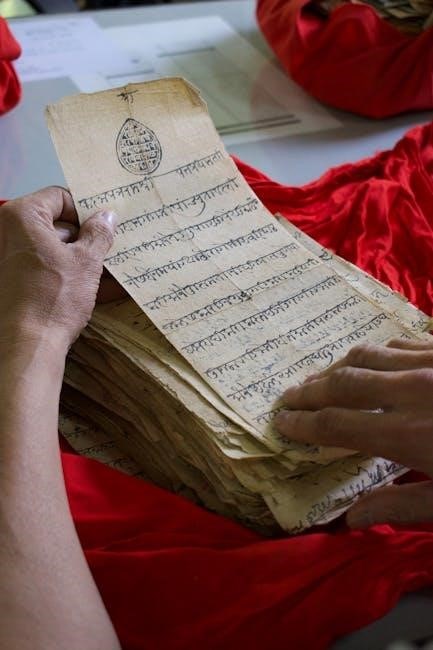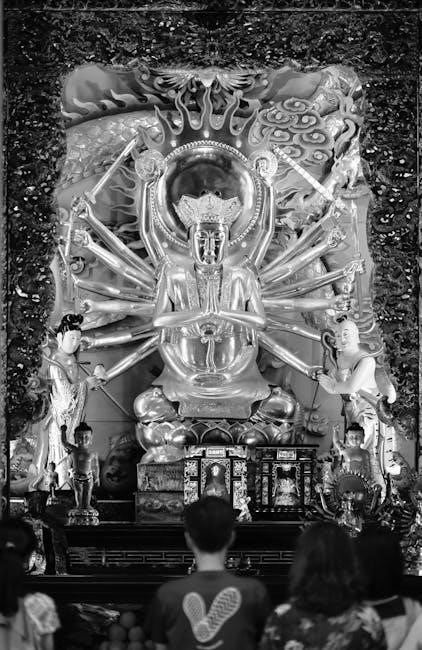Vishnu Sahasranama, an ancient Sanskrit hymn, lists 1,000 names of Lord Vishnu, a revered deity in Hinduism․ This sacred text is widely recited for spiritual enlightenment and divine connection, emphasizing its profound cultural and religious significance․
Overview of Vishnu Sahasranama
Vishnu Sahasranama is a foundational Hindu scripture, consisting of 1,000 names of Lord Vishnu, a central deity in Hinduism․ Originating from the Mahabharata, it is both a stotram (hymn of praise) and a namavali (list of names), offering profound spiritual insights․ Each name highlights Vishnu’s divine attributes, reinforcing His universal supremacy and benevolence․ Recited for centuries, it serves as a tool for devotion, self-reflection, and spiritual growth, embodying the essence of Vaishnavism and inspiring millions worldwide․
Significance of the Sanskrit Version
The Sanskrit version of Vishnu Sahasranama holds immense spiritual and linguistic significance․ As the original text, it preserves the hymn’s divine essence and phonetic purity, essential for accurate recitation and meditation․ Sanskrit’s sacred status in Hinduism ensures that the hymn’s potency remains intact, making it a preferred choice for rituals and worship․ Its intricate grammar and meter enhance the spiritual experience, connecting devotees deeply with Lord Vishnu, thus maintaining its timeless relevance and reverence in Hindu tradition and practice․
Why PDF Format is Popular
The PDF format is widely favored for Vishnu Sahasranama due to its universal accessibility and readability across devices․ It preserves the sacred text’s integrity, maintaining proper Sanskrit fonts and layouts․ PDFs are easily downloadable and sharable, making the hymn readily available for devotees worldwide․ The format also supports digital platforms, catering to modern preferences while preserving traditional content․ Its convenience and clarity have made it a preferred choice for daily recitation and spiritual practices, ensuring the text’s timeless availability in a user-friendly manner․

Origin and Background
Vishnu Sahasranama originates from the Mahabharata, specifically the Anushasana Parva, composed by Sage Vyasa․ This ancient Sanskrit hymn is over 5,000 years old, deeply rooted in Hindu scripture and theology․
Source in the Mahabharata
Vishnu Sahasranama is found in the Anushasana Parva of the Mahabharata, composed by Sage Vyasa․ It appears as a dialogue between Yudhishthira and Bhishma, where the latter recites the thousand names of Vishnu․ This sacred text is over 5,000 years old, deeply embedded in Hindu theology․ The hymn is structured in 142 verses, concluding with a verse on the attainment of peace and liberation․ Reciting it is believed to remove sins and fears, making it a cornerstone of devotion and spiritual growth in Hinduism․
Authorship and Composition
Vishnu Sahasranama is attributed to the revered Sage Vyasa, a prominent figure in Hindu scriptures․ It was recited by Bhishma in the Mahabharata, specifically in the Anushasana Parva․ The text is structured as 142 verses, including the 1,000 names of Vishnu, organized into groups of ten names each for easy recitation․ Composed in Sanskrit, it reflects ancient Indian philosophical traditions and Vaishnavite devotion․ The hymn’s composition is a testament to Vyasa’s spiritual wisdom, making it a cornerstone of Hindu liturgy and a revered text for devotees seeking enlightenment and divine connection․
Historical Context
Vishnu Sahasranama originates from the Mahabharata, specifically the Anushasana Parva, where it was recited by Bhishma to Yudhishthira during the Kurukshetra War․ This ancient Sanskrit text is rooted in the epic period of Hindu history, reflecting the theological and cultural milieu of the time․ Its composition in Sanskrit underscores its sacred status, as Sanskrit was the language of religious and scholarly discourse․ The text has been a cornerstone of Vaishnavite traditions for centuries, with its recitation and study becoming integral to Hindu spirituality and devotion, particularly in honoring Lord Vishnu․

Structure of the Text
Vishnu Sahasranama is structured as a list of 1,000 divine names of Lord Vishnu, written in Sanskrit, divided into sections for easy recitation and spiritual reflection, including Phala Shruti․
Divine Names and Their Meanings
The Vishnu Sahasranama contains 1,000 divine names of Lord Vishnu, each reflecting His attributes, roles, and virtues․ These names, such as “Vishnu” (the pervader) and “Hari” (the remover of sins), encapsulate His divine nature․ The text is both a Stotram (hymn) and a Namavali (list of names), offering profound spiritual insights․ Each name is a meditation on His universal presence, grace, and protection, inspiring devotion and self-reflection․ Understanding these meanings deepens the recitation experience, connecting devotees to Vishnu’s limitless essence․
Phala Shruti (Benefits of Recitation)
Reciting Vishnu Sahasranama is believed to bring immense spiritual and material benefits, as outlined in the Phala Shruti․ It is said to grant liberation from worldly bonds, bestow peace, and fulfill desires․ Regular recitation with faith and devotion is thought to purify the mind, protect from adversity, and ensure prosperity․ The text emphasizes that even listening to it with sincerity can lead to spiritual growth․ These benefits are deeply rooted in Hindu scriptures, making it a cherished practice for seekers of divine grace and enlightenment․
Difference Between Stotram and Namavali
Vishnu Sahasranama is presented in two forms: Stotram and Namavali․ The Stotram includes verses with poetic descriptions and hymns praising Lord Vishnu, while the Namavali is a straightforward list of his 1,000 names․ The Stotram provides context and devotion through its lyrical structure, whereas the Namavali focuses solely on the divine names for recitation․ Both forms are revered, but the Namavali is often preferred for daily chanting due to its simplicity and direct connection to the deity․ Together, they form a comprehensive tribute to Lord Vishnu’s glory and attributes․

Benefits and Significance
Vishnu Sahasranama holds profound spiritual significance, offering peace, prosperity, and divine connection․ Its recitation is vital in Hindu rituals, promoting mental clarity and inner harmony always․
Spiritual Benefits of Recitation
Reciting Vishnu Sahasranama brings profound spiritual benefits, including mental purification and stress relief․ It fosters inner harmony, enhances devotion, and strengthens the connection with the divine․ Regular recitation is believed to bestow peace, prosperity, and spiritual growth․ The hymn’s sacred vibrations uplift the soul, guiding seekers toward self-realization and eternal bliss․ Many devotees recite it daily to seek Lord Vishnu’s blessings, ensuring a balanced and enlightened life․ Its chanting is also known to alleviate emotional turmoil, promoting clarity and positivity in one’s life journey․
Role in Hindu Rituals and Worship
Vishnu Sahasranama holds a central place in Hindu rituals and worship, often recited during pujas, homas, and sacred ceremonies․ It is chanted to invoke Lord Vishnu’s blessings, ensuring spiritual cleansing and divine grace․ Many devotees incorporate it into daily worship, believing it strengthens their connection with the divine․ The hymn is also recited during auspicious occasions like weddings and griha pravesh, symbolizing prosperity and harmony․ Its recitation is particularly significant during Ekadashi and other Vrishni festivals, making it a vital component of Hindu religious practices and traditions․

The Vishnu Sahasranama in Sanskrit PDF is widely available for download from reputable sources like Exotic India Art and the Sanskrit Channel, offering easy access for devotees worldwide․
Importance of the Sanskrit Version
The Sanskrit version of Vishnu Sahasranama is revered for its authenticity and spiritual potency․ It preserves the original meter and pronunciation, essential for Vedic recitation․ Sanskrit, as a sacred language, ensures the hymn’s divine energy and connection to ancient traditions․ Reciting it in Sanskrit is believed to offer profound spiritual benefits, including purification of the mind and liberation from worldly bonds․ The PDF format maintains the purity of the text, making it ideal for daily recitation and rituals․ Its availability in Sanskrit underscores its cultural and religious significance, fostering a deeper link to Hindu heritage and spirituality․
Where to Download the PDF
The Sanskrit version of Vishnu Sahasranama is widely available online in PDF format․ Trusted platforms like Exotic India Art and Sanskrit Documents offer free downloads․ Additionally, websites such as Internet Archive and Scribd provide access to scanned manuscripts and digital versions․ Some spiritual organizations and temples also share downloadable links via their official websites or platforms like Google Drive․ Ensure to verify the source’s authenticity to download the correct and complete version of the text;
How to Use the PDF for Daily Recitation
Using the Sanskrit PDF of Vishnu Sahasranama for daily recitation is straightforward․ Begin by downloading the PDF from a trusted source and ensure it includes the correct Sanskrit text and diacritics․ Create a quiet, clean space for recitation, ideally during early morning hours․ Open the PDF and recite the names slowly, focusing on pronunciation and meaning․ Use bookmarks or page navigation for easy access․ Regular practice enhances spiritual benefits, so maintain consistency․ Some PDFs include audio guides or translations for better understanding, making daily recitation more effective and meaningful․

How to Recite Vishnu Sahasranama
Recite Vishnu Sahasranama in a calm, clean environment, seated comfortably․ Use a Sanskrit PDF for accuracy, focusing on pronunciation and meaning․ Regular practice enhances spiritual benefits․
Best Time and Place for Recitation
The ideal time for reciting Vishnu Sahasranama is during the Brahma Muhurta (early morning, 4:30–6:00 AM) or in the evening after sunset․ Choose a clean, quiet, and serene environment, such as a home altar or temple, to enhance focus and devotion․ Ensure personal purity by bathing beforehand and wearing clean clothes․ Sitting comfortably on a sacred mat or chair helps maintain concentration․ Using a Sanskrit PDF ensures authenticity and proper pronunciation, allowing for a deeply spiritual experience․
Rituals and Preparations

Before reciting Vishnu Sahasranama, followers perform specific rituals to purify themselves and their surroundings․ A holy bath is recommended to cleanse the body and mind․ Wearing clean, simple clothing and sitting in a tidy, sacred space enhances focus․ An altar is often set up with images or idols of Lord Vishnu, adorned with flowers and incense․ Lighting a diya (lamp) symbolizes the illumination of knowledge․ Offering prasad (sanctified food) and performing a brief prayer to seek blessings are also customary․ These preparations create a conducive environment for meaningful recitation and devotion․

Cultural and Historical Impact
Vishnu Sahasranama has profoundly influenced Hindu culture, inspiring art, music, and literature․ Its historical significance endures as a revered text, shaping spiritual and cultural practices for centuries․
Role in Hindu Culture
Vishnu Sahasranama holds a revered position in Hindu culture, serving as a cornerstone of devotion and spirituality․ It is widely recited in temples, homes, and during rituals, fostering a deep connection with the divine․ The text is integral to various religious ceremonies and daily prayers, emphasizing its cultural significance․ Its influence extends to art, music, and literature, inspiring numerous compositions and works․ The Sahasranama is also a unifying force, bridging regional and linguistic divides through its universal appeal and sacred verses․
Influence on Art and Music
Vishnu Sahasranama has profoundly influenced Hindu art and music, inspiring countless compositions and works․ Its verses are often set to melodic tunes in classical music traditions like Carnatic music․ In dance forms such as Bharatanatyam, the Sahasranama is frequently used as a lyrical base for performances․ The hymn’s rhythmic and devotional appeal has also shaped temple sculptures and paintings, depicting Lord Vishnu’s divine forms․ Its spiritual essence continues to inspire artistic expressions across generations, making it a timeless source of creative and cultural enrichment․

Translations and Interpretations
Vishnu Sahasranama is available in multiple translations, offering spiritual insights to diverse audiences․ English translations and scholarly interpretations enhance its accessibility, while commentaries by saints like Adi Shankara deepen its understanding․
Availability of Translations
The Vishnu Sahasranama is widely available in various translations, catering to diverse linguistic and cultural needs․ English, Hindi, Tamil, and other regional language versions are accessible, ensuring broader reach․ PDF formats of these translations are freely downloadable from websites like exoticindiaart․com and sanskritdocuments․org․ These resources are invaluable for spiritual seekers and scholars alike, offering interpretations that preserve the essence of the original Sanskrit text while making it understandable for modern audiences․
Commentaries and Bhashyams
Renowned scholars have provided detailed commentaries on the Vishnu Sahasranama, enriching its interpretation․ Parasara Bhattar’s Bhashya and Adi Shankara’s insights are highly revered, offering profound spiritual and philosophical understanding․ These commentaries are available in PDF formats, accessible through platforms like exoticindiaart․com and sanskritdocuments․org․ They serve as invaluable resources for both scholars and devotees, facilitating a deeper connection to the text’s sacred teachings and enhancing the recitation experience with meaningful explanations․

Modern Relevance
The Vishnu Sahasranama remains highly relevant today, with its digital availability in PDF formats making it accessible to a global audience․ It serves as a valuable educational and spiritual resource, bridging ancient traditions with modern technology for widespread dissemination and study․
Digital Access and Popularity
The digital age has revolutionized access to the Vishnu Sahasranama, with Sanskrit PDF versions widely available online․ Websites like Exotic India Art and Lal Bahadur Shastri Sanskrit University offer free downloads, making it easily accessible globally․ This digital popularity has increased its reach, especially among younger generations who prefer e-resources․ Mobile devices enable devotees to carry the PDF for daily recitation, fostering spiritual convenience․ Online forums and communities further enhance its popularity by sharing interpretations and benefits, ensuring its relevance in modern times while preserving ancient traditions․
Role in Education and Spirituality
Vishnu Sahasranama plays a pivotal role in both education and spirituality․ It is often taught in Sanskrit educational institutions to preserve ancient language and cultural heritage․ Spiritually, its recitation fosters devotion, mental clarity, and inner peace․ Many use the Sanskrit PDF for daily recitation, enhancing their spiritual practice․ It is also integrated into rituals and ceremonies, serving as a bridge between education and devotion․ This text is a cornerstone of Hindu spirituality, offering profound insights into the divine and guiding seekers on their spiritual journey while maintaining its educational significance․
Vishnu Sahasranama in Sanskrit PDF remains a timeless spiritual treasure, offering profound insights into Hinduism․ Its availability in PDF format ensures accessibility, fostering devotion and cultural preservation․
Final Thoughts on the Significance
Vishnu Sahasranama holds immense spiritual and cultural value, offering a profound connection to Lord Vishnu․ Its Sanskrit version, available in PDF, preserves ancient traditions and provides devotees with a convenient medium for daily recitation and reflection․ This sacred text not only enriches one’s spiritual journey but also serves as a vital resource for understanding Hindu philosophy and practices․
Encouragement to Explore the Text
Exploring the Vishnu Sahasranama in Sanskrit PDF offers a profound spiritual experience, allowing devotees to connect deeply with Lord Vishnu․ This ancient text, rich in philosophical insights, provides a pathway to inner peace and enlightenment․ By reciting or studying the Sanskrit version, one can experience the purity and elegance of the original composition․ The PDF format makes it accessible for modern readers to incorporate this sacred hymn into their daily routines, fostering a stronger bond with Hindu tradition and spirituality․
